Synthesis and Rheological Characterization of a Novel Salecan Hydrogel
Abstract
:1. Introduction
2. Materials and Methods
2.1. Materials
2.2. Preparation of Sal Hydrogels
2.3. Observations of Sol-Gel Transition
2.4. Characterization of Sal Hydrogel with Different Sal Concentration
2.4.1. Appearance Observation of Sal Hydrogel
2.4.2. Measurement of Color Values
2.4.3. Textural Properties Analysis
2.4.4. Test on Water Holding Capacity (WHC), Water Content (WC)
2.4.5. Investigation of Swelling Behavior
2.4.6. Rheological Analysis
2.4.7. Scanning Electron Microscope (SEM) Imaging
2.5. Statistical Analysis
3. Results
3.1. Preparation of Sal Hydrogel
3.2. Thermosensitivity of Sal Hydrogel
3.3. Characterization of Hydrogels
3.3.1. Sensory Characteristics
3.3.2. Textural Properties
3.3.3. Water Holding Capacity and Water Content
3.3.4. Swelling Analysis
3.3.5. Rheological Properties
3.3.6. SEM Analysis
4. Conclusions
Supplementary Materials
Author Contributions
Funding
Institutional Review Board Statement
Informed Consent Statement
Data Availability Statement
Acknowledgments
Conflicts of Interest
References
- Ahmed, E.M. Hydrogel: Preparation, characterization, and applications: A review. J. Adv. Res. 2015, 6, 105–121. [Google Scholar] [CrossRef] [PubMed] [Green Version]
- Sharma, G.; Sharma, S.; Kumar, A.; Al-Muhtaseb, A.H.; Naushad, M.; Ghfar, A.A.; Mola, G.T.; Stadler, F.J. Guar gum and its composites as potential materials for diverse applications: A review. Carbohyd. Polym. 2018, 199, 534–545. [Google Scholar] [CrossRef] [PubMed]
- McClements, D.J. Recent progress in hydrogel delivery systems for improving nutraceutical bioavailability. Food Hydrocoll. 2017, 68, 238–245. [Google Scholar] [CrossRef] [Green Version]
- Kim, M.K.; Sundaram, K.S.; Iyengar, G.A.; Lee, K.P. A novel chitosan functional gel included with multiwall carbon nanotube and substituted polyaniline as adsorbent for efficient removal of chromium ion. Chem. Eng. J. 2015, 267, 51–64. [Google Scholar] [CrossRef]
- Alavi, F.; Emam-Djomeh, Z.; Yarmand, M.S.; Salami, M.; Momen, S.; Moosavi-Movahedi, A.A. Cold gelation of curcumin loaded whey protein aggregates mixed with k-carrageenan: Impact of gel microstructure on the gastrointestinal fate of curcumin. Food Hydrocoll. 2018, 85, 267–280. [Google Scholar] [CrossRef]
- Zhou, L.P.; Xu, T.W.; Yan, J.C.; Li, X.; Xie, Y.Q.; Chen, H. Fabrication and characterization of matrine-loaded konjac glucomannan/fish gelatin composite hydrogel as antimicrobial wound dressing. Food Hydrocoll. 2020, 104, 105702. [Google Scholar] [CrossRef]
- Bonifacio, M.A.; Gentile, P.; Ferreira, A.M.; Cometa, S.; De Giglio, E. Insight into halloysite nanotubes-loaded gellan gum hydrogels for soft tissue engineering applications. Carbohyd. Polym. 2017, 163, 280–291. [Google Scholar] [CrossRef] [Green Version]
- Cui, Y.X.; Liu, X.; Yi, J.J.; Kang, Q.Z.; Hao, L.M.; Lu, J.K. Cognition of polysaccharides from confusion to clarity: When the next “omic” will come? Crit. Rev. Food Sci. 2021. [Google Scholar] [CrossRef]
- Abdelnasser, S.M.; Yahya, S.M.; Mohamed, W.F.; Asker, M.M.; Shady, H.M.A.; Mahmoud, M.G.; Gadallah, M.A. Antitumor Exopolysaccharides Derived from Novel Marine Bacillus: Isolation, Characterization Aspect and Biological Activity. Asian Pac. J. Cancer Prev. 2017, 18, 1847–1854. [Google Scholar] [CrossRef]
- Li, S.; Huang, R.; Shah, N.P.; Tao, X.; Xiong, Y.; Wei, H. Antioxidant and antibacterial activities of exopolysaccharides from Bifidobacterium bifidum WBINO3 and Lactobacillus plantarum R315. J. Dairy Sci. 2014, 97, 7334–7343. [Google Scholar] [CrossRef] [Green Version]
- Rico, C.W.; Shin, J.H.; Um, I.C.; Kang, M.Y. Cholesterol-lowering Action and Antioxidative Effects of Microbial Gum in C57BL/6N Mice Fed a High Fat Diet. Biotechnol. Bioprocess Eng. 2011, 16, 167–172. [Google Scholar] [CrossRef]
- Adebayo-Tayo, B.; Ishola, R.; Oyewunmi, T. Characterization, antioxidant and immunomodulatory potential on exopolysaccharide produced by wild type and mutant Weissella confusa strains. Biotechnol. Rep. 2018, 19, e00271. [Google Scholar] [CrossRef] [PubMed]
- Yildiz, H.; Karatas, N. Microbial exopolysaccharides: Resources and bioactive properties. Process Biochem. 2018, 72, 41–46. [Google Scholar] [CrossRef]
- Qi, X.L.; Zhang, M.Y.; Su, T.; Pan, W.H.; Tong, X.Q.; Zeng, Q.K.; Xiong, W.; Jiang, N.; Qian, Y.N.; Li, Z.P.; et al. Biocompatible Hydrogels Based on Food Gums with Tunable Physicochemical Properties as Scaffolds for Cell Culture. J. Agric. Food Chem. 2020, 68, 3770–3778. [Google Scholar] [CrossRef]
- Xiu, A.H.; Zhou, M.Y.; Zhu, B.; Wang, S.M.; Zhang, J.F. Rheological properties of Salecan as a new source of thickening agent. Food Hydrocoll. 2011, 25, 1719–1725. [Google Scholar] [CrossRef]
- Qi, X.L.; Wei, W.; Shen, J.L.; Dong, W. Salecan polysaccharide-based hydrogels and their applications: A review. J. Mater. Chem. B 2019, 7, 2577–2587. [Google Scholar] [CrossRef]
- Florian, P.E.; Icriverzi, M.; Ninciuleanu, C.M.; Alexandrescu, E.; Trica, B.; Preda, S.; Ianchis, R.; Roseanu, A. Salecan-Clay Based Polymer Nanocomposites for Chemotherapeutic Drug Delivery Systems; Characterization and In Vitro Biocompatibility Studies. Materials 2020, 13, 5389. [Google Scholar] [CrossRef]
- Zhou, M.Y.; Pu, C.L.; Xia, L.; Yu, X.H.; Zhu, B.; Cheng, R.; Xu, L.X.; Zhang, J.F. Salecan diet increases short chain fatty acids and enriches beneficial microbiota in the mouse cecum. Carbohyd. Polym. 2014, 102, 772–779. [Google Scholar] [CrossRef]
- Fu, R.J.; Li, J.; Zhang, T.; Zhu, T.R.; Cheng, R.; Wang, S.M.; Zhang, J.F. Salecan stabilizes the microstructure and improves the rheological performance of yogurt. Food Hydrocoll. 2018, 81, 474–480. [Google Scholar] [CrossRef]
- Hu, X.; Wang, Y.; Zhang, L.; Xu, M. Formation of self-assembled polyelectrolyte complex hydrogel derived from salecan and chitosan for sustained release of Vitamin C. Carbohyd. Polym. 2020, 234, 115920. [Google Scholar] [CrossRef]
- Wei, W.; Qi, X.L.; Liu, Y.C.; Li, J.J.; Hu, X.Y.; Zuo, G.C.; Zhang, J.F.; Dong, W. Synthesis and characterization of a novel pH-thermo dual responsive hydrogel based on salecan and poly(N,N-diethylacrylamide-co-methacrylic acid). Colloids Surf. B Biointerfaces 2015, 136, 1182–1192. [Google Scholar] [CrossRef] [PubMed]
- Qi, X.L.; Hu, X.Y.; Wei, W.; Yu, H.; Li, J.J.; Zhang, J.F.; Dong, W. Investigation of Salecan/poly(vinyl alcohol) hydrogels prepared by freeze/thaw method. Carbohyd. Polym. 2015, 118, 60–69. [Google Scholar] [CrossRef] [PubMed]
- Wei, W.; Qi, X.L.; Li, J.J.; Zhong, Y.; Zuo, G.C.; Pan, X.H.; Su, T.; Zhang, J.F.; Dong, W. Synthesis and characterization of a novel cationic hydrogel base on salecan-g-PMAPTAC. Int. J. Biol. Macromol. 2017, 101, 474–480. [Google Scholar] [CrossRef] [PubMed]
- Qi, X.L.; Yuan, Y.; Zhang, J.F.; Bulte, J.W.M.; Dong, W. Oral Administration of Salecan-Based Hydrogels for Controlled Insulin Delivery. J. Agric. Food Chem. 2018, 66, 10479–10489. [Google Scholar] [CrossRef] [PubMed]
- Su, T.; Qi, X.L.; Zuo, G.C.; Pan, X.H.; Zhang, J.F.; Han, Z.W.; Dong, W. Polysaccharide metallohydrogel obtained from Salecan and trivalent chromium: Synthesis and characterization. Carbohyd. Polym. 2018, 181, 285–291. [Google Scholar] [CrossRef]
- Liu, J.L.; Liu, F.H.; Ren, T.; Wang, J.; Yang, M.X.; Yao, Y.; Chen, H. Fabrication of fish gelatin/sodium alginate double network gels for encapsulation of probiotics. J. Sci. Food Agric. 2021, 101, 4398–4408. [Google Scholar] [CrossRef]
- Kchaou, H.; Benbettaieb, N.; Jridi, M.; Abdelhedi, O.; Karbowiak, T.; Brachais, C.H.; Leonard, M.L.; Debeaufort, F.; Nasri, M. Enhancement of structural, functional and antioxidant properties of fish gelatin films using Maillard reactions. Food Hydrocoll. 2018, 83, 326–339. [Google Scholar] [CrossRef]
- Bengoechea, C.; Ortiz, S.E.M.; Guerrero, A.; Puppo, M.C. Effect of pH on the thermal gelation of carob protein isolate. J. Food Sci. Technol. Mys. 2017, 54, 153–163. [Google Scholar] [CrossRef] [Green Version]
- Oliveira, R.N.; McGuinness, G.B.; Ramos, M.E.T.; Kajiyama, C.E.; Thiré, R.M.S.M. Properties of PVA Hydrogel Wound-Care Dressings Containing UK Propolis. Macromol. Symp. 2016, 368, 122–127. [Google Scholar] [CrossRef]
- Dragan, E.S.; Humelnicu, D.; Dinu, M.V. Development of chitosan-poly(ethyleneimine) based double network cryogels and their application as superadsorbents for phosphate. Carbohyd. Polym. 2019, 210, 17–25. [Google Scholar] [CrossRef]
- Deng, C.N.; Liu, Y.; Li, J.L.; Yadav, M.P.; Yin, L.J. Diverse rheological properties, mechanical characteristics and microstructures of corn fiber gum/soy protein isolate hydrogels prepared by laccase and heat treatment. Food Hydrocoll. 2018, 76, 113–122. [Google Scholar] [CrossRef]
- Liu, C.; McClements, D.J.; Li, M.; Xiong, L.; Sun, Q. Development of Self-Healing Double-Network Hydrogels: Enhancement of the Strength of Wheat Gluten Hydrogels by In Situ Metal-Catechol Coordination. J. Agric. Food Chem. 2019, 67, 6508–6516. [Google Scholar] [CrossRef] [PubMed]
- Kazemi-Taskooh, Z.; Varidi, M. Designation and characterization of cold-set whey protein-gellan gum hydrogel for iron entrapment. Food Hydrocoll. 2021, 111, 106205. [Google Scholar] [CrossRef]
- Iijima, M.; Shinozaki, M.; Hatakeyama, T.; Takahashi, M.; Hatakeyama, H. AFM studies on gelation mechanism of xanthan gum hydrogels. Carbohyd. Polym. 2007, 68, 701–707. [Google Scholar] [CrossRef]
- Li, Z.; Su, Y.; Xie, B.; Liu, X.; Gao, X.; Wang, D. A novel biocompatible double network hydrogel consisting of konjac glucomannan with high mechanical strength and ability to be freely shaped. J. Mater. Chem. B 2015, 3, 1769–1778. [Google Scholar] [CrossRef]
- Camesano, T.A.; Wilkinson, K.J. Single molecule study of xanthan conformation using atomic force microscopy. Biomacromolecules 2001, 2, 1184–1191. [Google Scholar] [CrossRef]
- Simi, C.K.; Abraham, T.E. Transparent xyloglucan–chitosan complex hydrogels for different applications. Food Hydrocoll. 2010, 24, 72–80. [Google Scholar] [CrossRef]
- Zhu, J.-H.; Yang, X.-Q.; Ahmad, I.; Li, L.; Wang, X.-Y.; Liu, C. Rheological properties of κ-carrageenan and soybean glycinin mixed gels. Food Res. Int. 2008, 41, 219–228. [Google Scholar] [CrossRef]
- Urbonaite, V.; de Jongh, H.H.J.; van der Linden, E.; Pouvreau, L. Permeability of gels is set by the impulse applied on the gel. Food Hydrocoll. 2015, 50, 7–15. [Google Scholar] [CrossRef]
- Nieuwland, M.; Bouwman, W.G.; Pouvreau, L.; Martin, A.H.; de Jongh, H.H.J. Relating water holding of ovalbumin gels to aggregate structure. Food Hydrocoll. 2016, 52, 87–94. [Google Scholar] [CrossRef]
- Gierszewska, M.; Ostrowska-Czubenko, J.; Chrzanowska, E. pH-responsive chitosan/alginate polyelectrolyte complex membranes reinforced by tripolyphosphate. Eur. Polym. J. 2018, 101, 282–290. [Google Scholar] [CrossRef]
- Xu, Q.; Huang, W.; Jiang, L.; Lei, Z.; Li, X.; Deng, H. KGM and PMAA based pH-sensitive interpenetrating polymer network hydrogel for controlled drug release. Carbohyd. Polym. 2013, 97, 565–570. [Google Scholar] [CrossRef] [PubMed]
- Pal, K.; Banthia, A.K.; Majumdar, D.K. Preparation and characterization of polyvinyl alcohol-gelatin hydrogel membranes for biomedical applications. AAPS PharmSciTech 2007, 8, 21. [Google Scholar] [CrossRef] [PubMed]
- Chen, Q.; Zhu, L.; Zhao, C.; Wang, Q.M.; Zheng, J. A Robust, One-Pot Synthesis of Highly Mechanical and Recoverable Double Network Hydrogels Using Thermoreversible Sol-Gel Polysaccharide. Adv. Mater. 2013, 25, 4171–4176. [Google Scholar] [CrossRef] [PubMed]
- Gao, S.; Nishinari, K. Effect of deacetylation rate on gelation kinetics of konjac glucomannan. Colloids Surf. B Biointerfaces 2004, 38, 241–249. [Google Scholar] [CrossRef] [PubMed]
- Peng, H.; Chen, S.; Luo, M.; Ning, F.; Zhu, X.; Xiong, H. Preparation and Self-Assembly Mechanism of Bovine Serum Albumin-Citrus Peel Pectin Conjugated Hydrogel: A Potential Delivery System for Vitamin C. J. Agric Food Chem. 2016, 64, 7377–7384. [Google Scholar] [CrossRef]
- Pankongadisak, P.; Suwantong, O. Enhanced properties of injectable chitosan-based thermogelling hydrogels by silk fibroin and longan seed extract for bone tissue engineering. Int. J. Biol. Macromol. 2019, 138, 412–424. [Google Scholar] [CrossRef]



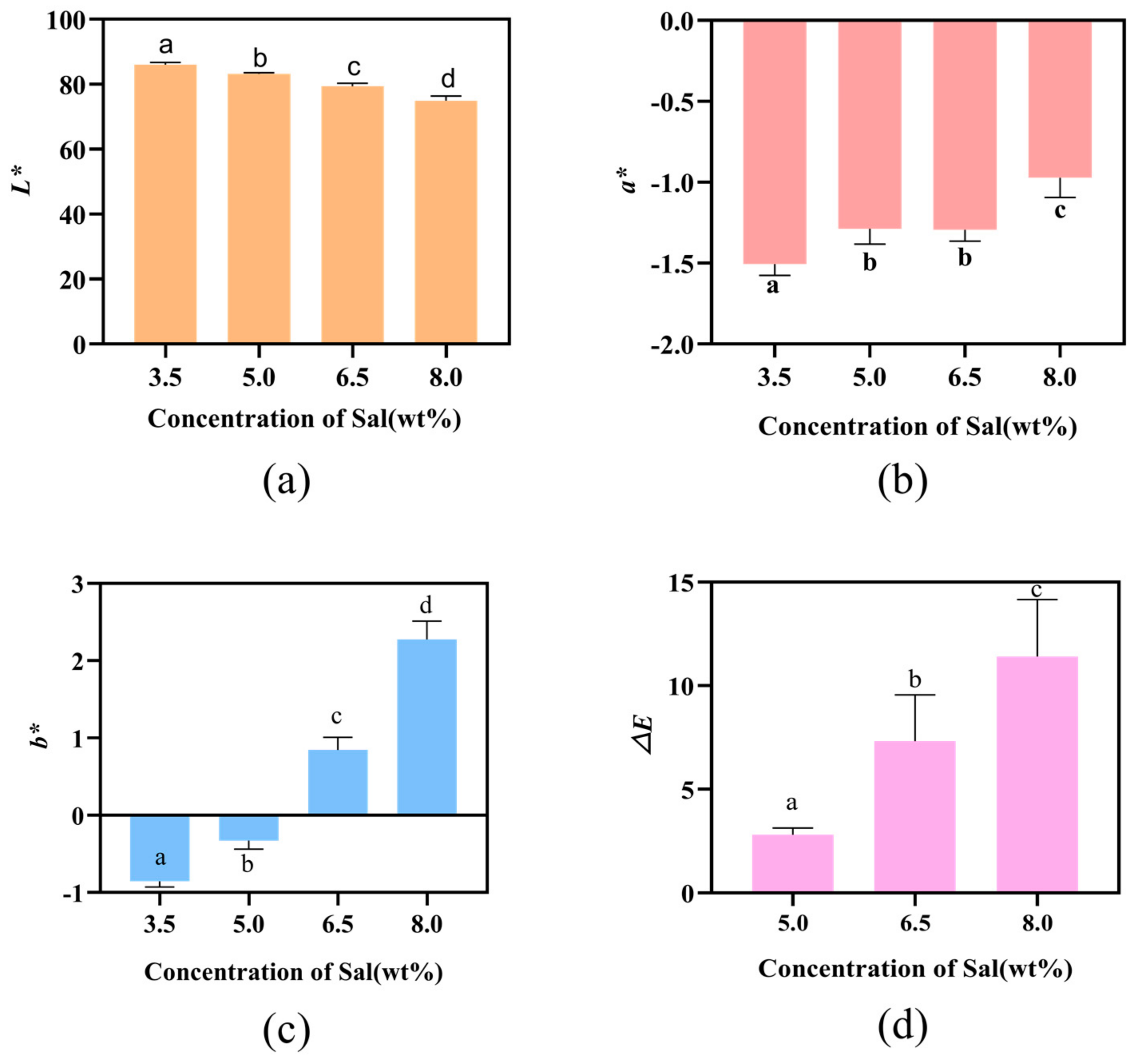
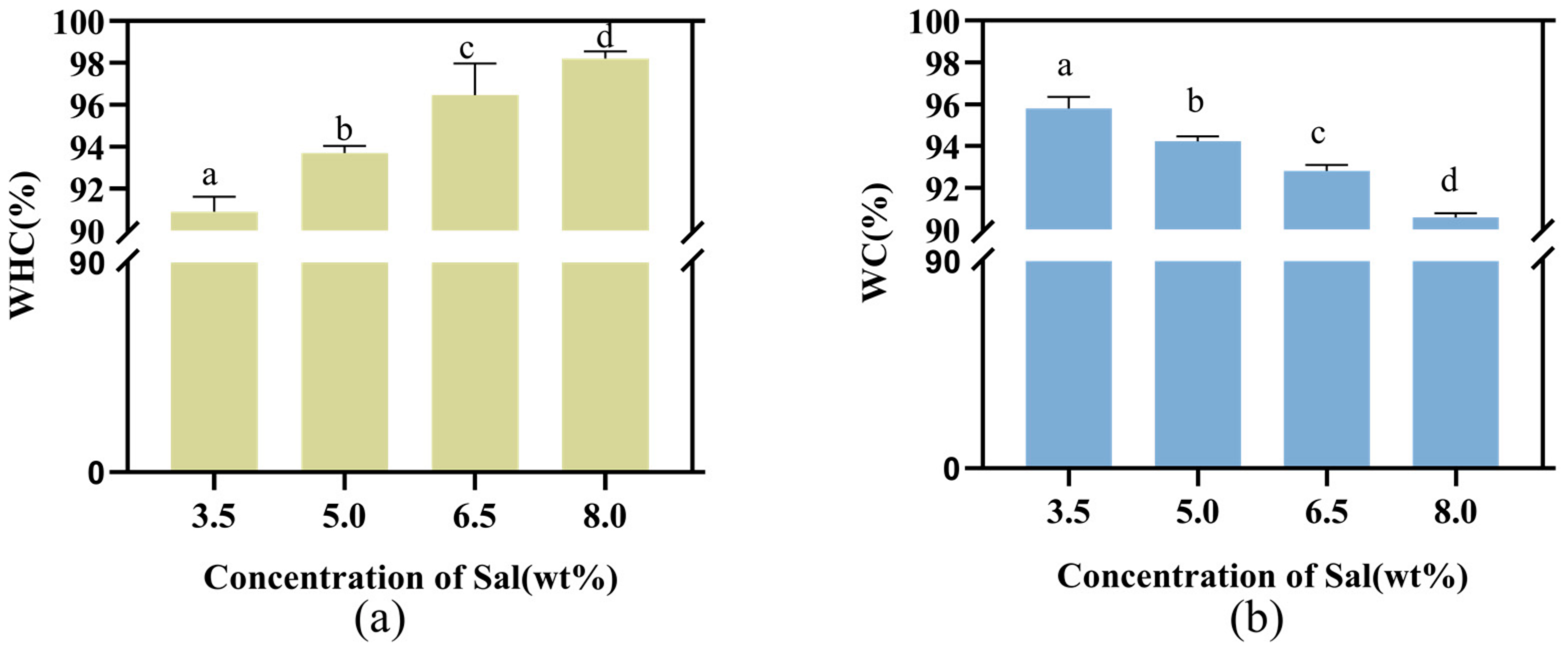
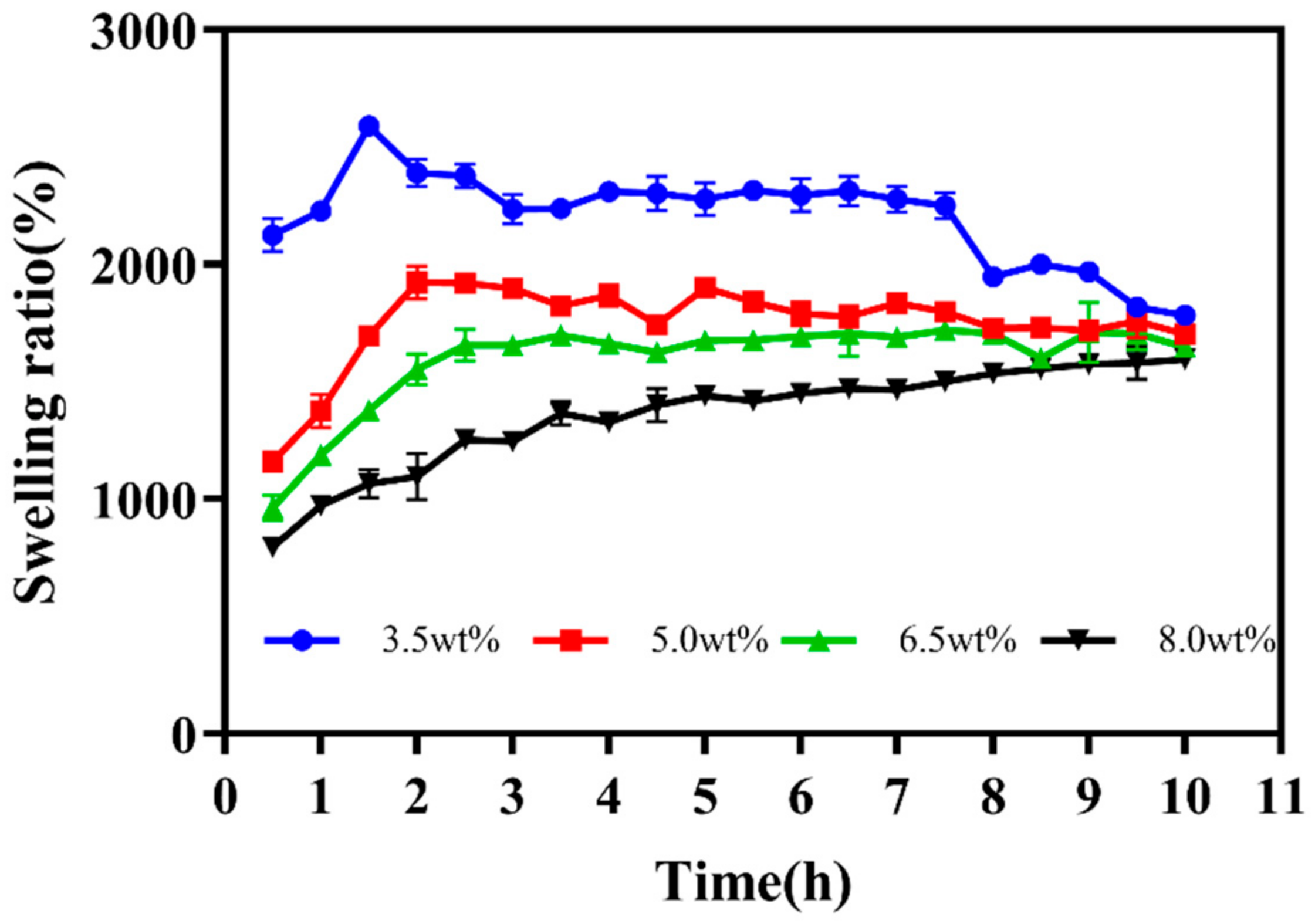
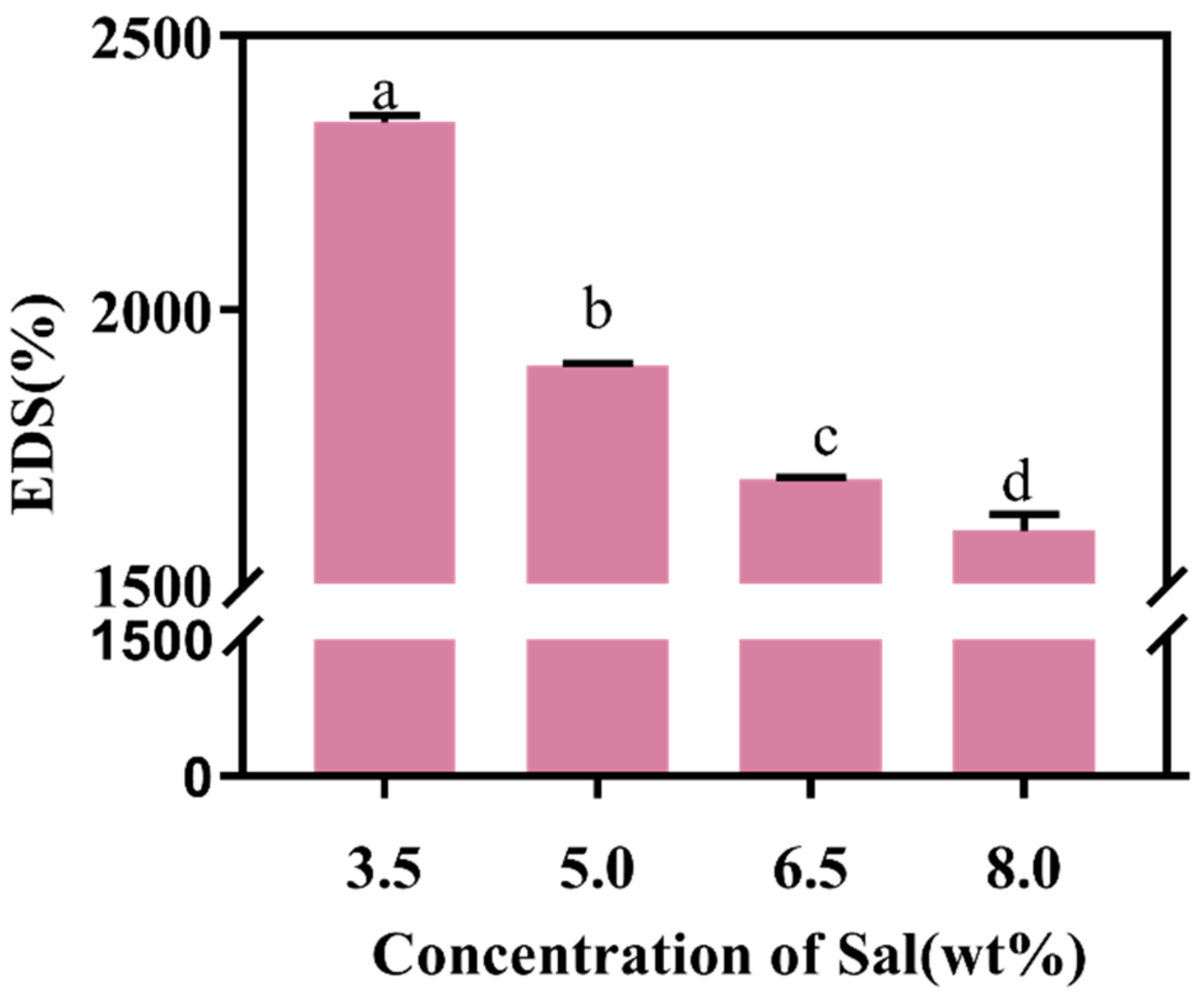
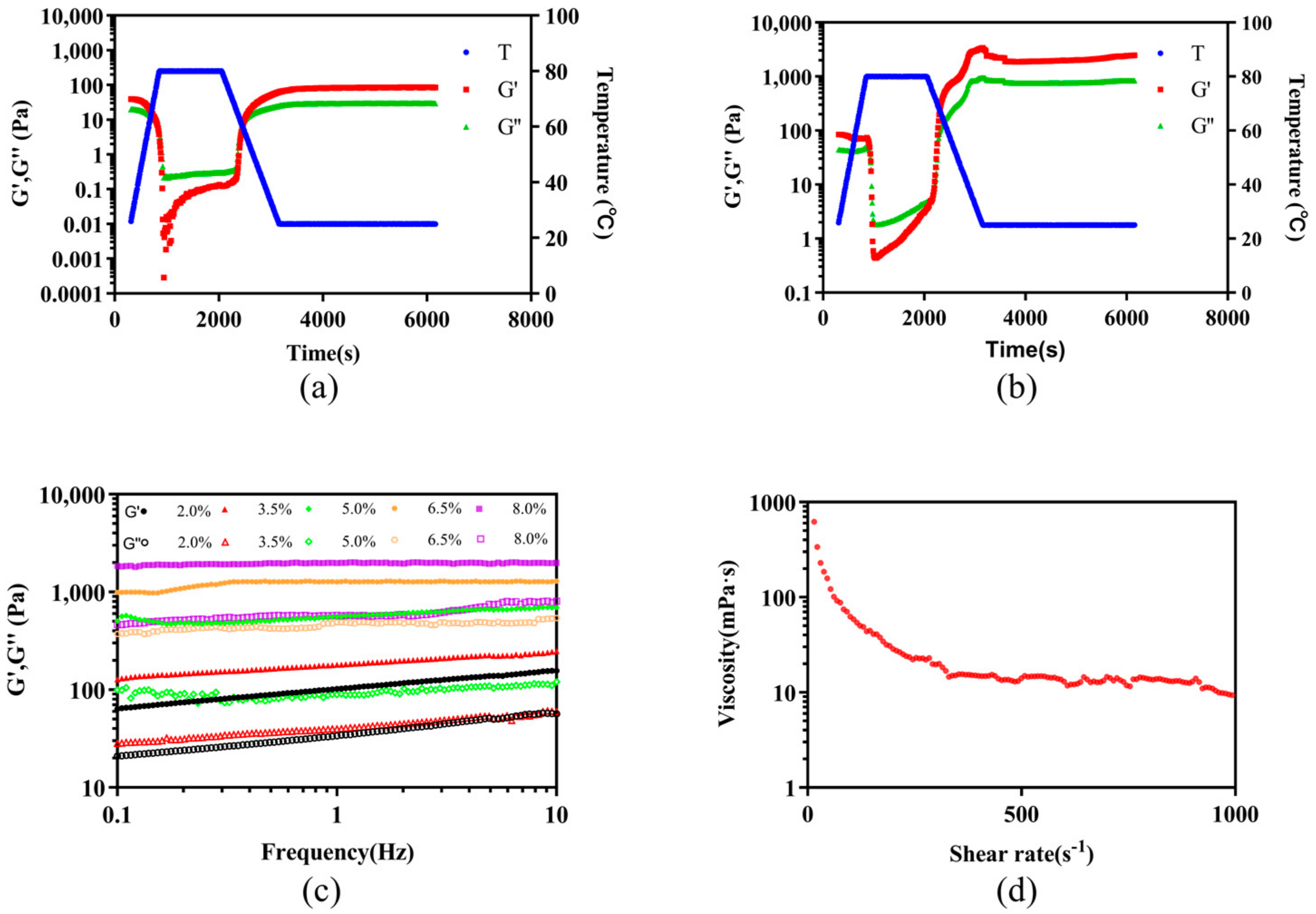
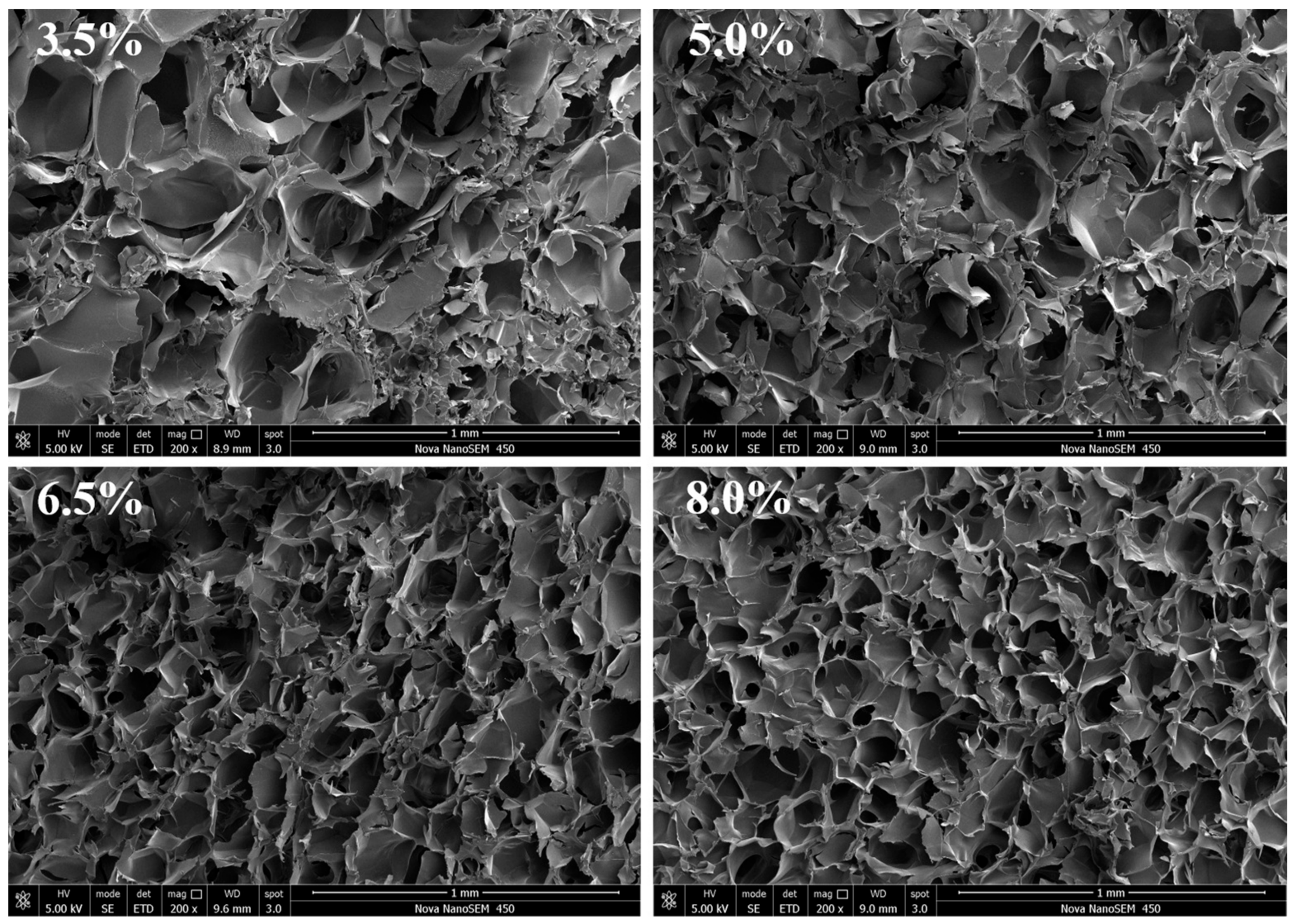
| Color Values | Implications |
|---|---|
| 1.6 < ΔE < 3.2 | Cannot distinguish its color difference |
| 3.2 < ΔE < 6.5 | A few people can tell the difference in colors |
| 6.5 < ΔE < 13 | The color difference is very obvious |
| 13 < ΔE < 25 | Most belong to different colors |
| ΔE > 25 | Different colors |
| C (wt%) | 0.5 | 2.0 | 3.5 | 5.0 | 6.5 | 8.0 | |
|---|---|---|---|---|---|---|---|
| T (°C) | |||||||
| 50 | - | - | - | - | - | - | |
| 60 | - | - | - | - | - | - | |
| 70 | - | - | - | - | - | - | |
| 80 | - | - | + | ++ | ++ | +++ | |
| 90 | - | + | ++ | ++ | +++ | +++ | |
| Concentration (wt%) | Hardness (N) | Springiness (mm) | Chewiness (mJ) | Cohesiveness (%) |
|---|---|---|---|---|
| 3.5 | 0.88 ± 0.12 c | 0.29 ± 0.66 b | 0.12 ± 0.06 b | 0.5 ± 0.01 b |
| 5.0 | 1.56 ± 0.04 b | 0.94 ± 0.04 a | 1.27 ± 0.12 a | 0.63 ± 0.06 a |
| 6.5 | 1.72 ± 0.09 ab | 1.18 ± 0.18 a | 1.47 ± 0.50 a | 0.63 ± 0.06 a |
| 8.0 | 2.07 ± 0.22 a | 1.21 ± 0.11 a | 1.73 ± 0.31 a | 0.70 ± 0.01 a |
Publisher’s Note: MDPI stays neutral with regard to jurisdictional claims in published maps and institutional affiliations. |
© 2022 by the authors. Licensee MDPI, Basel, Switzerland. This article is an open access article distributed under the terms and conditions of the Creative Commons Attribution (CC BY) license (https://creativecommons.org/licenses/by/4.0/).
Share and Cite
Zhang, Q.; Ren, T.; Gan, J.; Sun, L.; Guan, C.; Zhang, Q.; Pan, S.; Chen, H. Synthesis and Rheological Characterization of a Novel Salecan Hydrogel. Pharmaceutics 2022, 14, 1492. https://doi.org/10.3390/pharmaceutics14071492
Zhang Q, Ren T, Gan J, Sun L, Guan C, Zhang Q, Pan S, Chen H. Synthesis and Rheological Characterization of a Novel Salecan Hydrogel. Pharmaceutics. 2022; 14(7):1492. https://doi.org/10.3390/pharmaceutics14071492
Chicago/Turabian StyleZhang, Qinling, Teng Ren, Jing Gan, Lirong Sun, Chenxia Guan, Qian Zhang, Shihui Pan, and Hao Chen. 2022. "Synthesis and Rheological Characterization of a Novel Salecan Hydrogel" Pharmaceutics 14, no. 7: 1492. https://doi.org/10.3390/pharmaceutics14071492
APA StyleZhang, Q., Ren, T., Gan, J., Sun, L., Guan, C., Zhang, Q., Pan, S., & Chen, H. (2022). Synthesis and Rheological Characterization of a Novel Salecan Hydrogel. Pharmaceutics, 14(7), 1492. https://doi.org/10.3390/pharmaceutics14071492







